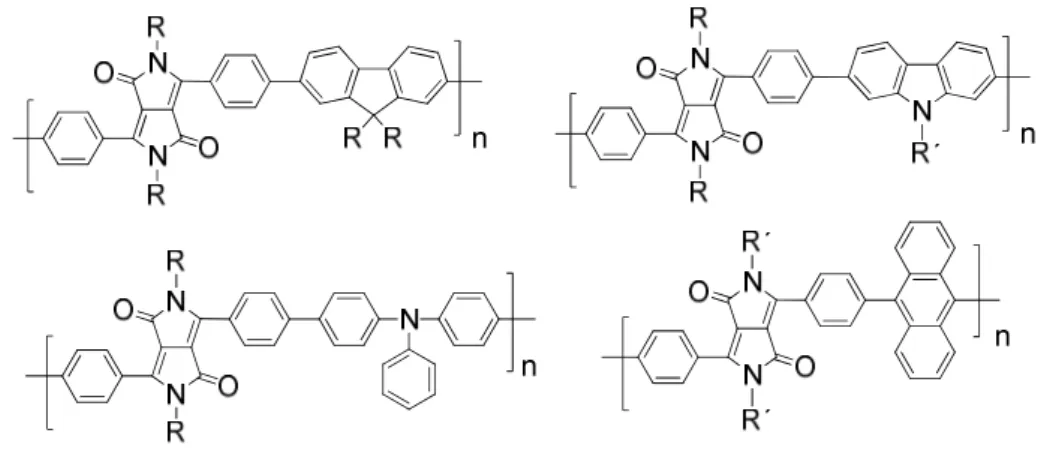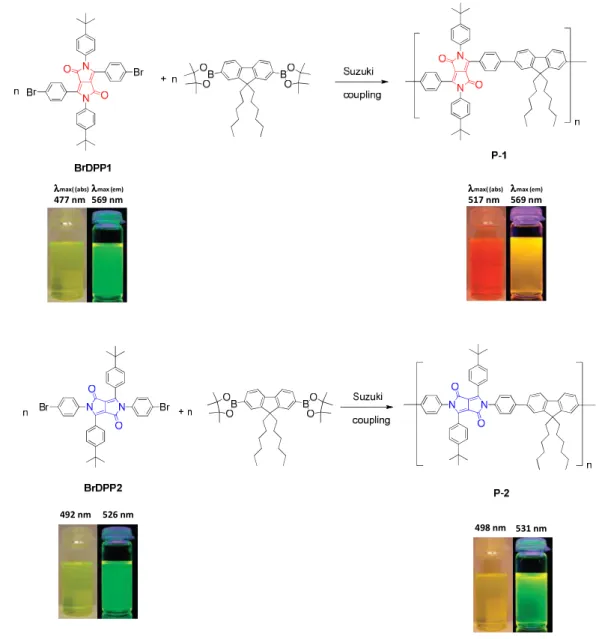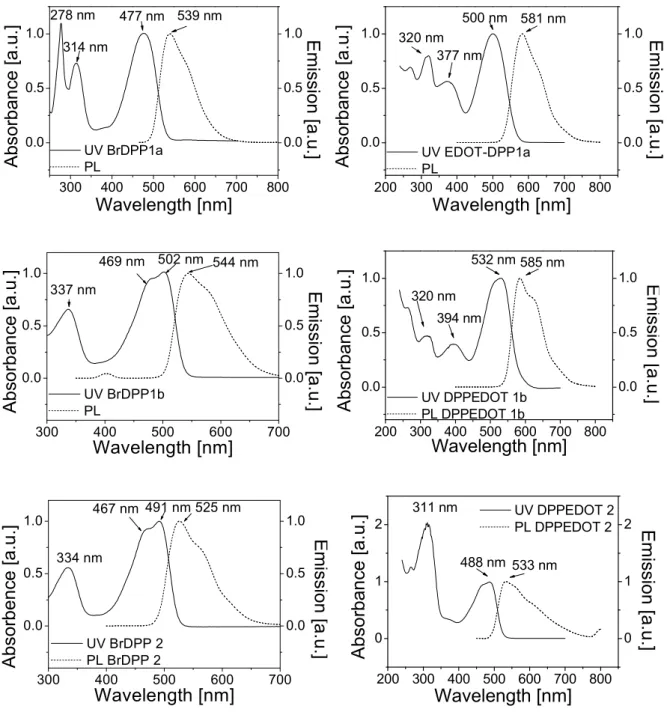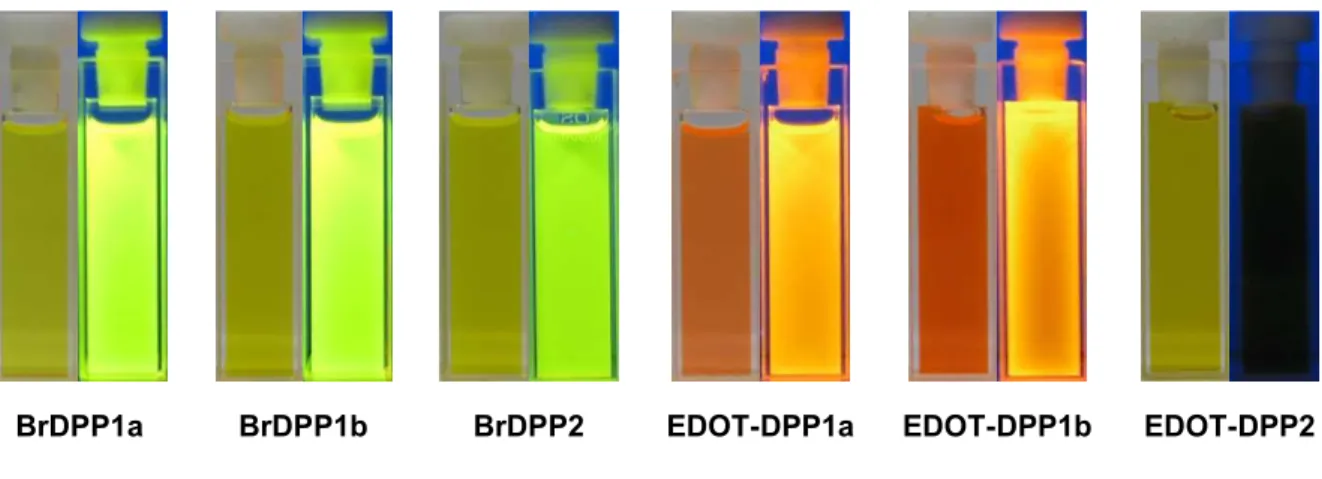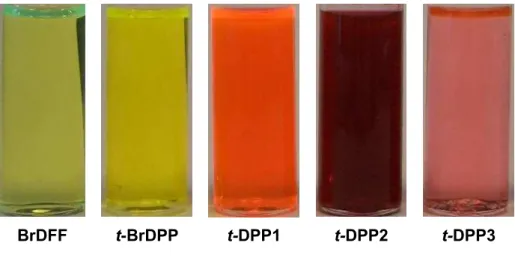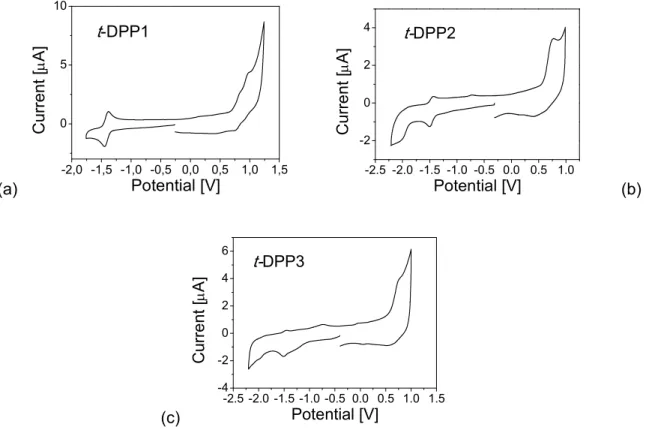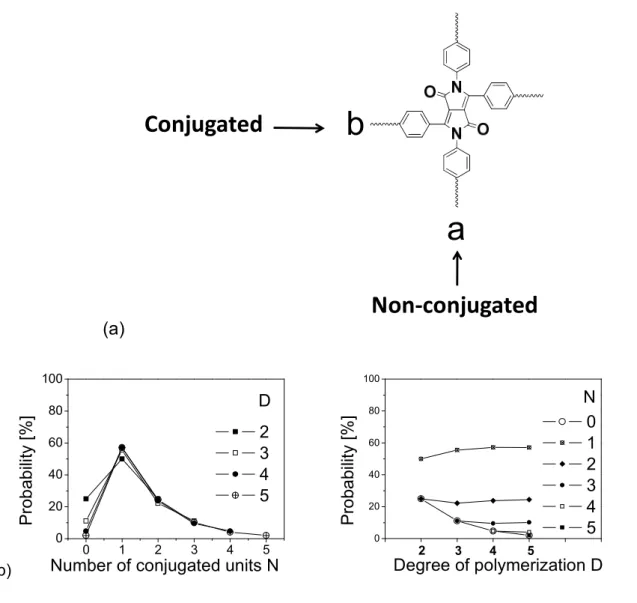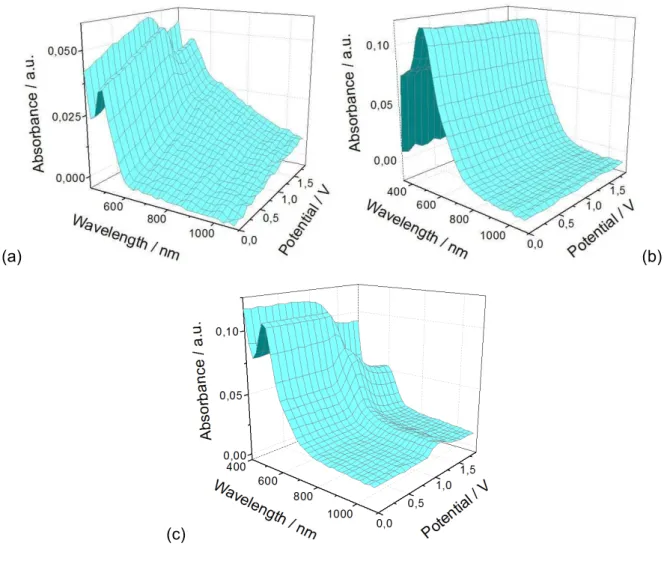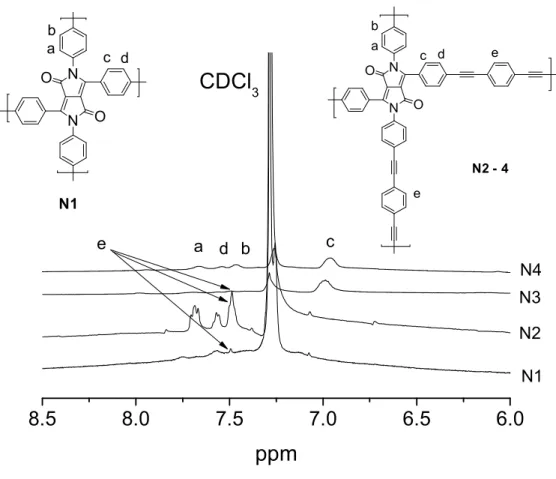New Conjugated Polymers
Based on Benzodifuranone and Diketopyrrolopyrrole
Inaugural-Dissertation zur
Erlangung des Doktorgrades
der Mathematisch-Naturwissenschaftlichen Falkutät der Unversität zu Köln
vorgelegt von
Kai Zhang
aus V.R. China
Köln 2010
Berichterstatter:
Prof. Dr. Bernd Tieke Prof. Dr. Ulrich K. Deiters
Tag der mündlichen Prüfung: 26.11.2010
Abstract
In this work synthesis and properties of new conjugated polymers containing diketopyrrolopyrrole (DPP) and benzodifuranone (BZDF) chromophores in the main chain, which are suitable as active materials in optoelectronic applications. The polymers were synthesized by metal-mediated or -catalyzed Suzuki, Stille, Sonogashira and Yamamoto cross-coupling polycondensation reactions, or by using anodic electropolymerization. The resulting polymers were characterized using gel permeation chromatography, NMR-, UV/vis-, and fluorescence spectroscopy, mass spectroscopy, and cyclic voltrammetry.
Using anodic electropolymerization, polymers containing 2,3,5,6-arylated DPPwere prepared.The incorporation of the tetra-functional DPP chromophore in a linear polymer chain via its 2- and 5- aryl unitsresults in non-π-conjugated polymers exhibiting HOMO- LUMO band gaps of about 3 eV, whereas incorporation via the aryl units in the 3- and 6- positions results in π-conjugated polymers with HOMO-LUMO gaps between 1.3 and 2eV, and the polymers exhibit electrochromic properties.The cross-linked polymers show a very broad absorption with maxima around 510 nm, exhibiting HOMO-LUMO band gaps between 1.3and 2 eV. Cross-linked polymer networks prepared according to Yamamoto and Sonogashiracoupling show mesoporous properties. They exhibit BET surface areas up to 500 m
2g
-1, and show micoporositiesin the range from 17 to 38%.In addition, the influence of the thermal cleavage of the Boc-group on the optical and electrochemical properties of the Boc-protected ThienylDPP-polymers was studied. It was shown that, after removal of the Boc-groups, the polymers generally exhibit broader absorption bands and higher HOMO- and lower LUMO-levels, resulting in lower HOMO-LUMO gaps.
Furthermore,entirely new conjugated polymers containing the benzodifuranone (BZDF)
chromophore in the main chain were synthesized. The polymers were preparedbypalladium-
catalyzed Suzuki cross-couplingpolycondensation, or by anodic electropoly-merization, and
are of potential interest for photovoltaic or electrochromic devices.The polymers show very
broad absorption bands with maxima up to 600 nm, exhibiting extinction coefficients in the
range from 25 000 to 60 000 L mol
-1cm
-1. The polymers exhibitvery low band gaps in the
range from 0.40 to 1.2 eV. Oxidation and reduction processes are reversible, which suggests
a strong donor-acceptor character. Electrochromic properties were found upon reduction, the
polymers showingcolour changes from dark red to almost transparent.
Einführung
Ziel dieser Arbeit war die Herstellung und Charakterisierung neuer konjugierten Polymereaud Basis von Diketopyrrolopyrrol (DPP) und Benzodifuranon (BZDF) als aktive Materialien für optoelektronische Anwendungen. Die Polymere wurden mit Hilfe der metal-katalysierten Kupplungen nach Suzuki, Stille, Sonogashira, und Yamamoto und durch anodische Elektropolymerization hergestellt. Die resultierenden Polymere wurden mit Hilfe der Gelpermeationschromatograpie, NMR-, UV/vis-, und Fluoreszenzspektroskopie, Massen- spektrometrie sowie Zyklovoltammetrie untersucht.
Mit Hilfe der Elektropolymerization wurden Polymere auf Basis der2,3,5,6-arylierten DPP- Einheit mit Comonomeren wie Thiophen, EDOT oder EDTT hergestellt. Sie weisen eine konjugierte Polymerkette auf, die durch die 3- und 6-Positionen der zentralen DPP-Einheit verläuft.Ihre HOMO-LUMO-Bandlücke liegt zwischen1,30 und 2 eV und siezeigen elektrochrome Eigenschaften. Polymere, deren Kette durch die 2- und 5-Positionen der DPP- Einheit verläuft, sind dagegen nicht konjugiert. Sie weisen eine Bandlücke von 3 eV auf. Die vernetzten DPP-Polymere zeigen sehr breite Absorptionsbanden mit Maxima um 500 nm und HOMO-LUMO-Bandlücken zwischen 1,3 und 2 eV. Die hergestellten Polymernetzwerke nach Yamamoto und Sonogashira weisen mesoporöse Eigenschaften auf. Sie zeigen BET- Oberflächen bis zu 500 m
2g
-1undMikroporositäten von 17 bis 38%.Außerdem wurde der Einfluß der thermischen Abspaltung der Boc-Gruppe auf die optischen und elektrochemischen Eigenschaften von ThienylDPP-Polymeren untersucht. Es zeigt sich, dass die Polymere nach der Abspaltung der Boc-Gruppe breitere Absorptionsbanden,höhere HOMO- und niedrigere LUMO-Levels aufweisen.
Desweiteren wurden konjugierte Polymereauf Basis von Benzodifuranon, die für die Anwendungen wie Photovoltaik oder elektrochrome Bauteilegeeignet sein können, durch Palladium-katalysierte Suzuki-Kupplung oder anodische Elektropolymerisation hergestellt.
Die Polymere zeigen sehr breite Absorptionsbanden mit Maxima bis zu 600 nm und
Extinktionskoeffizienten von 25 000 bis 60 000 L mol
-1cm
-1. Außerdem weisen sie sehr kleine
HOMO-LUMO-Bandlücken von 0,4 bis 1,2 eV auf. Oxidations- und Reduktionsprozesse sind
reversibel. Reversible elektrochrome Eigenschaften der Polymere treten beider kathodischen
Reduktion auf. Die Farbe ändert sich von dunkelrot nach fast farblos.
Acknowledgement
First of all, I would like to express my deepest thanks to my doctoral supervisor Prof. Bernd Tieke for the opportunity to work on this fascinating topic in his group, and for his invaluable advice, guidance, inspiration, patience and support throughout my doctoral studies. With his comprehensive knowledge, enthusiasm, manner of scientific thinking, he has given me a role model as a researcher. I am very grateful that he allowed me to take part of international cooperations in Scotland.
I sincerely thank Dr. Raman Rabindranath and Dr. Yu Zhu for the helpful advice and support in my beginning time in the group. Especially all the evening discussions contributed largely to the accomplishment of this work.
My warmest thanks go to Prof. Peter Skabara of the Department of Pure and Applied Chemistry at University of Strathclyde, Glasgow, Scotland, for his guidance, encouragement,and hospitality in Glasgow. Working in his group was a great pleasure.
Dr. Filipe Vilela, Dr. John Forgie, and Dr. Alexander Kanibolotsky are thanked for the help and cooperation in Glasgow.
I thank my friend and also classmate Dr. Alexander Kühne for his help and advice during the Cologne andGlasgow time, and for introducing me in some Scotland’s insiders.
I thank all the colleagues in my group, Anna, Ali, Ashraf, Belinda, Gülara, Iana, Irina, Julia, Kalie, Kristina, Philipp, Olga,Sogand, and Tatjana, for the pleasant and inspiring atmosphere in the group.
I also thank the students, Annett Rabis, FriederikeRohrbach, Malte Flory, Melanie Wienberg,SamanGhasimiandMirko Müller, whom I co-supervisedduring their laboratory internships,for their good performances and help.
Many thanks go to Mrs. Regina Ryba-Cheng and Mrs. Anna Maier for their help as secretaries.
I thank Prof. UlrichK. Deiters for his attendance as a referee.
I thank Mr. James Morrow for performance of the gas sorption measurements, and Ms Ruth Brucker for the SEM measurements.
I acknowledge the financial support and supply on DPP pigments by BASF Schweiz AG,
Basel, Switzerland, and Dr. Mathias Düggeli, Dr. Roman Lenz, and Dr. Pascal Hayoz, for
their cooperations and helpful discussions. Mr. Mahmoud ZaherEteishand Mr. Stefan Läuger are thanked for their help at BASF during the work in Basel, Switzerland.
I thank my friends Mirko and Hao for their invaluable advice, support and keeping up with my sometimes foolish moods in these years.
At last but not least, I would like to express my heartfelt thanks to my parents for their advice,
encouragement, and unconditional love and support through these years.
I
TABLE OF CONTENS
List ofacronyms IV
1 Introduction 1
2 Overview 2
2.1 Conceptofthework 2
2.2 Diketopyrrolopyrrole 4
2.2.1 DPP monomers 4
2.2.2 DPP-containingpolymers 7
2.3 Benzodifuranone 14
2.4 Metal-mediated and -catalyzed coupling reactions 17
2.5 Electropolymerization 22
2.6 Electronic applications of conjugated polymers 28
2.6.1 Organic photovoltaic cells 28
2.6.2 Electroluminescent applications 31
2.6.3 Electrochromism 33
2.7 Conjugated microporous polymers 34
3 Conjugated polymers based on diketopyrrolopyrrole (DPP) 40
3.1 2,5- and 3,6-Di-substituted pyrrolo[3,4-c]pyrrole-1,4(2H,5H)-dione (DPP)-
based conjugated linear polymers 40
3.1.1 Synthesis and properties of monomers 41
3.1.2 Electropolymerization and properties of polymers 44 3.2 2,3,5,6-Tetra-substituted pyrrolo[3,4-c]pyrrole-1,4(2H,5H)-dione (DPP)-
based conjugated polymers 53
II
3.2.1 2,3,5,6-Tetra-functionalized pyrrolo[3,4-c]pyrrole-1,4(2H,5H)-dione (DPP)
monomers 53
3.2.2 Electropolymerization, optical and electrochemical properties of the polymers 59 3.3 Conjugated mesoporous poly(pyrrolo[3,4-c]pyrrole-1,4(2H,5H)-dione) (DPP)
networks 66
3.4 Oligomers based on 2,3,5,6-tetraphenylpyrrolo[3,4-c]pyrrole-1,4(2H,5H)-
dione (DPP) 75
3.5 Conjugated polymers based on thienyl-DPP 79
3.5.1 Conjugated alternating polymer containing Boc-substituted thienyl-DPP 79
3.5.2 Conjugated copolymers based on Boc-ThDPP 85
3.5.3 New thienyl-DPP 90
3.6 Conclusion 92
4 Conjugated polymers based on benzodifuranone 94
4.1 Symmetrical benzodifuranone-based conjugated polymers prepared via
electropolymerization 94
4.1.1 3,7-Diphenylbenzo[1,2-b:4,5-b']difuran-2,6-dione-based conjugated polymers
prepared via electropolymerization 96
4.1.1.1 Synthesis and properties of electropolymerizable monomers 96 4.1.1.2 Polymers prepared via electropolymerization 100 4.1.2 3,6-Diphenylbenzo- [1,2-b:6,5-b']difuran-2,7-dione-based conjugated
polymers prepared via electropolymerization 106
4.1.2.1 Synthesis and properties of electropolymerizable monomers 108 4.1.2.2 Polymers prepared via electropolymerization 112 4.2 Symmetrical benzodifuranone-based conjugated polymers prepared via
palladium-catalyzed cross-coupling polycondensation 118 4.2.1 Conjugated polymers prepared via Suzuki cross-coupling polycondensation 119
4.2.1.1 Synthesis and properties of the monomers 119
III
4.2.1.2 Synthesis and properties of the polymers 121
4.3 Symmetrical benzodifuranone-based conjugated polymers prepared via
chemical oxidative polymerization 125
4.4 Unsymmetrical benzodifuranone-based conjugated polymers 129 4.4.1 Synthesis and properties of unsymmetrical benzodifuranone monomers 129 4.4.2 Polymers prepared via Suzuki and Stille cross-coupling polycondensations 132
4.4.3 Polymers prepared via electropolymerization 136
4.4.3.1 Synthesis and properties of the monomers 136
4.4.3.2 Polymers prepared via electropolymerization 139
4.5 Diphenylnaphthodifurandione 142
4.6 Conclusion 145
5 Experimental part 144
5.1 Materials 144
5.2 Instrumentation and general procedures 144
5.3 Synthesis 146
5.3.1 Diketopyrrolopyrrole-based conjugated polymers 146
5.3.2 Conjugated polymers based on benzodifuranone 172
5.3.2.1 Conjugated polymers based on symmetrical benzodifuranone 172 5.3.2.2 Conjugated polymers based on unsymmetrical benzodifuranone 188
6 References 204
IV
List ofacronyms
δ Chemical shift
λ Wavelength
Φ Photoluminescence quantum yield
A Ampere
BZDF Benzodifuranone
cm Centimeter
CV Cyclic voltammertry
Da Dalton
DCM Dichloromethane
DMF N,N-Dimethylformamide DMSO Dimethylsulfoxide DPP Diketopyrrolopyrrole
EC Electrochromic
EDOT 3,4-Ethylenedioxithiophene EDTT 3,4-Ethylenedithiathiophene
EL Electroluminescence
FL Fluorescence
g Gram
GPC Gel permeation chromatography
h Hour
HOMO Highest occupied molecular orbital
IR Infrared
LED Light emitting diode
LUMO Lowest unoccupied molecular orbital
min Minute
mm Milimeter
nm Nanometer
Mp Melting point
NMR Nuclear magnetic resonance
PD Polydispersity
PFET Polymeric field effect transistors
PL Photoluminescence
PLED Polymeric light emitting diodes
PVC Polymeric photovoltaic cells
V
RT Room temperature
THF Tetrahydrofuran
UV Ultraviolet
V Volt
vis Visible light
wt.% Weight percent
1
1 Introduction
The tremendously growing demand for energy throughout the world has addressed great emphasis on exploring clean and renewable energy resources. One of the most important long-term solutions is to harvest energy directly from the sunlight using photovoltaic technology. Since it was discovered in 1970 that polyacetylene can be rendered electrochemically conductive,
1polymeric photovoltaic cells (PVC)
2have become a promising alternative due to the easy fabrication onto large areas of flexible substrates and the possibility of solution processing at low cost.
3Due to their outstanding optical and electrochemical properties, conjugated polymers also have attracted much attention in other application fields such as polymeric light emitting diodes (PLED)
4and polymeric field effect transistors (PFET).
5Among the applications, high grade light emitting diodes with very high efficiencies and considerably long life times are already commercially available. For the pioneering work in the field, A. MacDiarmid, A. Heeger, and H. Shirakawa were awarded with the Nobel Prize in 2000. Since that time, a vast number of research works focusing on the preparation and modulation of the properties of conjugated polymers has been published.
In order to obtain polymeric electronic materials, it is necessary to design and synthesize conjugated polymers with suitable properties, such as low HOMO-LUMO gaps, broad absorption range, high electron and hole mobility, and appropriate molecular energy levels.
One useful strategy to design new conjugated polymers for electronic applications is to
incorporate chromophores which are highly absorbing or emitting in the visible and near
infrared region into π-conjugated polymer chains. Potentially useful chromophores can be
found among the various organic colourants, especially in the field of so-called “high-
performance pigments” developed in the last three decades.
6This work is concerned with
the incorporation of such chromophores in conjugated polymer chains and the
characterization of the optical and electrochemical properties of the resultant polymers.
2
2 Overview
In this chapter, the concept of this work and a brief overview on preparation, key properties and application fields of the conjugated polymers will be given.
2.1 Concept of the work
Among the so-called “high-performance pigments” 2,5-diketopyrrolo[3,4-c]pyrrole (DPP) and its derivatives have been one of the key subjects in our research group in the last decade. In our previous work,
7as shown in Scheme 2.1, 3,6-diphenylfuro[3,4-c]furan-1,4-dione (DFF) was used as the starting compound for preparation of two isomeric bifunctional monomers DPP1 and 2. Corresponding linear polymers were synthesized and characterized. Continuing this subject, tetra-functional DPP monomers (t-DPP) will be synthesized. Polymerization will result in cross-linked polymers, which are suitable for electronic applications or for gas storage due to the porous surface area, will be obtained via metal-mediated and -catalyzed cross-coupling polycondensation reactions, or by using the method of electropolymerization under anodic conditions. For comparison, DPP-based polymers will also be synthesized under similar reaction conditions, and the influence of the substitution pattern on optical and electrochemical properties will be studied.
Scheme 2.1. Synthetic strategy for new DPP-based conjugated polymers.
3 In addition, thienylDPP monomers will be substituted with t-butoxycarbonyl (Boc)-group and the corresponding polymers will be synthesized via palladium-catalyzed Suzuki cross-
coupling polycondensation reaction. A special emphasis will be paid to the influence of the thermal cleavage of the Boc-group on the optical and electrochemical properties of the polymers.
As a second topic, an entirely new conjugated polymer will be synthesized containing the benzodifuranone (BZDF) chromophore in the main chain. The BZDF moiety is related to the DPP chromophore mentioned above in the following way. Derived from the structure of 3,6- diphenylfuro[3,4-c]furan-1,4-dione (DFF), 3,6-diphenylfuro-[3,2-b]furan-2,5-dione (isoDFF) represents an isomer of DFF. Incorporation of a phenyl unit between the two furanone groups results in a molecule with a larger conjugated system, the compound being denoted as 3,7-diphenylbenzo[1,2-c:4,5-c']difuran-1,5-dione (BZDF) (Scheme 2.2).
Scheme 2.2. Relation between structures of DFF and BZDF.
BZDF has been commercialized as disperse dye for textiles. Despite the early discovery of the benzodifuranone chromophores, only few research articles have been published.
Incorporation of benzodifuranone chromophores into polymer chains has never been reported, although it might be interesting for its extended π-system and its quinoid structure, from which a strong light absorption in the visible can be expected. In order to realize BZDF- based polymers, the following work will be carried out:
• A synthetic method for preparation of a bifunctional benzodifuranone monomer suitable for palladium-catalyzed polycondensation reactions will be developed.
• Benzodifuranone monomers will be incorporated in conjugated polymer chains. The
benzodifuranone-based conjugated polymers will be synthesized via palladium-
catalyzed cross-coupling polycondensation reactions, or by using the
electropolymerization method.
4
• Various comonomers containing electron-donating or -withdrawing groups will be used. The influence of the BZDF units on the optical and electrochemical properties of the polymers will be studied. New polymers exhibiting high HOMO- and low LUMO- level resulting in low band gaps, which are suitable for polymer solar cells, will be developed.
• The ease of reduction of polymers based on benzodifuranone will be used to prepare electrochromic devices and study their cathodic reduction using spectroscopic methods.
Furthermore, the polymers will be characterized using NMR-, UV/vis absorptions-, photoluminescence, and infrared spectroscopy, cyclic voltammetry, and gel permeation chromatography (GPC). The cross-linked polymer networks will be investigated using scanning electron microscope (SEM) and nitrogen adsorption and desorption analysis.
In order to facilitate a better understanding of the research work, an overview of diketopyrrolopyrrole and its polymers, the benzodifuranone chromophore, metal-catalyzed cross-coupling reactions, and electrochemical reactions for the synthesis of the polymers, and application of the polymers in solar cells, electroluminescent and electrochromic devices, and as rigid microporous systems for gas storage will be given in the following.
2.2 Diketopyrrolopyrrole
2.2.1 DPP monomers
2,5-Diketopyrrolo[3,4-c]pyrrole (DPP) (Fig. 2.1) and its derivatives have been commercialized since the 1980s, and have been the subject of many patents, despite the fact that for a considerable time only a few publications dealt with these compounds. In recent years, a growing number of polymer chemists and physicists have become interested in DPPs since it was shown that DPP-containing polymers exhibit light-emitting and photovoltaic properties.
Fig. 2.1. Structure of 3,6-diphenyl-substituted 2,5-diketopyrrolo[3,4-c]pyrrole (DPP).
5 3,6-Diphenyl-substituted DPP (diphenylDPP) was first reported by Farnum et al. in 1974 (Scheme 2.3).
8Instead of the desired product, diphenylDPP was obtained in low yield.
Scheme 2.3. Synthetic route to DPP according to Farnum et al.
In 1983, Iqbal, Cassar, and Rochat
9reported an elegant synthetic pathway for DPP derivatives. After the reaction of benzonitrile (or other aromatic nitriles) with succinic acid diesters, DPP derivatives could be prepared in a single reaction step in high yield (Scheme 2.4). Numerous DPP derivatives were synthesized since, their colour ranging from orange yellow via red to purple. Many DPP derivatives exhibit a high photostability in the solid state, weather fastness, deep colour, luminescence with large Stokes-shift, and a brilliant red colour allowing technical applications in colouring of fibers, plastics, surface coatings such as prints or inks.
Scheme. 2.4. Synthetic route to DPP using aromatic nitriles and succinic esters.
6
The electron-withdrawing effect of the lactam units supplies the chromophore with a high electron affinity. Strong hydrogen bonding between the lactam units favours the chromophores into physically cross-linked chain structures in the solid state, which is the origin for the poor solubility (Fig. 2.2).
10Short distances between the chromophore planes (0.336 nm) and phenyl ring planes (0.354 nm) lead to π−π-interactions via molecular orbital overlapping and exciton coupling effects.
10-11Electronic interactions and strong intermolecular forces also cause a high thermal stability up to 500 °C.
Fig. 2.2. Hydrogen bonds between the DPP units in the solid state.
For chemical incorporation into conjugated polymers, the solubility of the DPP compound needs to be increased, and the chromophore needs to be functionalized with polymerizable groups. The solubility can be increased by N-alkylation
12, arylation
13or acylation
14of the lactam units preventing hydrogen bond formation between the chromophores. Polymerizable groups can be attached to the aryl units in the 3- and 6-position of the central DPP chromophore,
15or to the lactam substituent groups.
16Suitable polymerizable groups are halogen atoms (especially bromine and iodine), hydroxyl, trifluoromethylsulfonate, or aldehyde groups (Fig. 2.3).
Fig. 2.3. Various DPP derivatives.
7 2.2.2 DPP-containing polymers
The first DPP-based polymer was described by Chan et al. in 1993.
17Conjugated block copolymers containing phenylene, thienylene and N-alkyl substituted diphenylDPP units in the main chain were synthesized by Stille coupling (Fig. 2.4). Photorefractive polymers were prepared containing a conjugated main chain and nonlinear optically active (nlo) chromophores in the side chain. DPP was incorporated in the polymers as a sensitizer for charge carrier generation.
Some years later, Eldin and coworkers described DPP-containing polymers obtained by radical polymerization of bis-acryloyl-substituted DPP derivatives.
16Polymer networks containing non-conjugated, copolymerized DPP units were prepared. Linear DPP-containing polyesters and polyurethanes were first described by Lange and Tieke in 1999.
18The polymers were soluble and could be cast into orange films exhibiting a strong fluorescence with maxima at 520 nm and a large Stokes shift of 50 nm. Due to the aliphatic structure of the main chain, the thermal stability was rather poor. Photoluminescent polyelectrolyte- surfactant complexes were obtained from an amphiphilic, unsymmetrically substituted DPP- derivative by complex formation with polyallylamine hydrochloride or polyethyleneimine.
19The complexes exhibit a mesomorphous structure, the glass transition depending on the structure of the polyelectrolyte.
Fig. 2.4. The first reported DPP containing conjugated polymer.
The first synthesis of conjugated DPP-polymers and copolymers by Pd-catalyzed Suzuki
coupling was reported by Tieke and Beyerlein in 2000 (Fig. 2.5).
20The polymers contained
N-hexyl-substituted diphenylDPP units and hexyl-substituted 1,4-phenylene units in the main
8
chain. Molecular weights up to 21 kDa were determined. Compared with the monomer, the optical absorption of the polymer in solution was bathochromically shifted by 12 nm, the maximum appearing at 488 nm. The polymer showed a bright red fluorescence with a maximum at 544 nm. In addition to the alternating copolymer, also copolymers with lower DPP content were prepared. All copolymers showed the DPP absorption at 488 nm, the ε- value being a linear function of the DPP content. By UV irradiation the copolymers gradually decomposed. The rate of photodecomposition increased with decreasing DPP:phenylene comonomer ratio. Two different photoprocesses were recognized: a slow process originating from the absorption of visible light by the DPP chromophore, and a rapid one originating from additional absorption of UV-light by the phenylene comonomer unit, followed by energy transfer to the DPP chromophore. The actual mechanism of photodecomposition remained unclear. Comparative studies indicated that conjugated DPP-containing polymers are considerably more stable than the DPP monomers or non-conjugated DPP-polymers.
Fig. 2.5. Conjugated DPP-containing polymers prepared by Pd-catalyzed Suzuki coupling.
Smet et al. used a step sequence of Suzuki couplings to prepare rod-like DPP-phenylene
oligomers with well-defined length.
21The resulting oligomers contained three, five and seven
DPP units, respectively. Unfortunately, the effect of the chain length on absorption and
emission behavior was not reported. A study on thermomesogenic polysiloxanes containing
DPP units in the main chain was published in 2001.
22Investigations of the thermotropic
phase behaviour using polarizing microscopy revealed nematic and smectic enantiotropic
phases. In the same year, a first study on electroluminescent (EL) properties of a DPP-
containing conjugated polymer was reported. Beyerlein et al.
23studied a DPP-
dialkoxyphenylene copolymer in a multilayer device of ITO/DPP-polymer/OXD7/Ca/-Mg:Al:Zn
and observed a red emission with maximum at about 640 nm. DeSchryver et al. synthesized
dendrimer macromolecules with a DPP core.
24Embedded in a coated polystyrene film, single
dendrimer molecules could be imaged with a confocal microscope utilizing the strong
9 fluorescence of the DPP core. It could be shown that the orientation of the absorption transition dipole of single dendrimer molecules in the film changed in a time span of seconds.
In recent years a number of studies were reported on synthesis, optical, electrochemical, and electroluminescent properties of conjugated DPP polymers. The polymers were prepared by Suzuki, Heck, and Stille coupling and other catalytic polycondensation reactions.
Fig. 2.6. DPP-containing polymer according to Rabindranath et al.
Rabindranath et al.
25synthesized a new DPP polymer entirely consisting of aryl-aryl coupled diphenyl-DPP units (Fig. 2.6). In solution the polymer exhibits a bordeaux-red colour with absorption maxima of about 525 nm, and a purple luminescence with maxima around 630^nm, the Stokes-shift being about 105 nm. Cyclovoltammetric studies indicated quasi- reversible oxidation and reduction behaviour, the band gap being about 2 eV.
In a comprehensive study, Zhu et al. prepared a number of highly luminescent DPP-based conjugated polymers (Fig. 2.7).
26The polymers consisted of dialkylated DPP units and carbazole, triphenylamine, benzo[2,1,3]thiadiazole, anthracene, or fluorene units in alternating fashion exhibiting yellow to red absorption and emission colours, and fluorescence quantum yields up to 86%. EL devices prepared with the polymer containing DPP and fluorene exhibited an external quantum efficiency (EQE) of 0.5% and a brightness at 20 V of 50 cd m
-2without much optimization. The maximum emission was at 600 nm, the turn-on voltage was 3.5 V. Cao et al.
27prepared DPP-fluorene copolymers, the DPP content varying between 0.1 and 50%. It was found that absorption and emission spectra, both in solution and thin film, varied regularly with the DPP content in the copolymers. By an increase of the DPP content, the absorption only shifted by a few nanometers to longer wavelength, whereas the emission bathochromically shifted by more than 40 nanometers. EL properties of the copolymers were also studied. With increasing DPP content the EL colours varied from orange to red corresponding to CIE coordinates from (0.52, 0.46) to (0.62, 0.37).
The best performance was achieved for an orange emitting device with a copolymer
10
containing only 1% DPP units. The EQE was 0.45%, the maximum brightness 520 cd m
-2. At high DPP content, the EQE was lowered to 0.14%, and the brightness to 127 cd m
-2, similar to the results reported by Zhu et al.
26Fig. 2.7. Examples of DPP-containing polymers according Zhu et al.
Novel vinylether-functionalized polyfluorenes for active incorporation in common photoresist materials were described by Kühne et al.
28Among the polymers investigated was a diphenylDPP-fluorene copolymer, the fluorene units carrying ethyl vinylether groups in the 9,9´-position. The vinyl ether functionality allowed for active incorporation of the light emitting polymers into standard vinyl ether or glycidyl ether photoresist materials, the polymers retaining their solution fluorescence characteristics. This enabled photopatterning of light- emitting structures for application in UV-down-conversion, waveguiding, and laser media.
Using Stille coupling, Zhu et al.
29first succeeded in the synthesis of copolymers containing
diphenylDPP and thiophene, bisthiophene, or 3,4-ethylenedioxythiophene (EDOT) units in
alternating fashion, which exhibited a maximum absorption of 560 nm. A solution-cast film of
the same polymer had a λ
max-value of 581 nm, and band gaps up to 1.7 eV, which were, due
to the strong donor-acceptor interaction between the thiophene and the DPP units,
considerablely smaller than for the previously reported DPP-based polymers (Fig. 2.8).
11
S S S S
O O Ar =
N O N
O C
6H
13C
6H
13Ar
n
Fig. 2.8. DPP-containing polymers prepared by Stille-coupling.
In a further study
30the incorporation of arylamine units in the main chain was attempted according to the synthetic pathway reported by Hartwig,
31Buchwald,
32and Kanbara.
33The examples of the polymers are displayed in Fig. 2.9. Due to presence of electron-rich nitrogen atoms, the donor-acceptor interactions along the main chain were enhanced causing a red- shift of the absorption and emission. Furthermore, the presence of easily oxidizable nitrogen in the main chain gave rise to a lower oxidation potential of the polymers. The solutions of the polymers in chloroform exhibit a purple red colour with absorption maxima between 530 and 550 nm, and emission maxima from 610 to 630 nm. Fluorescence quantum yields are moderate (20 to 60%). The nitrogen atoms in the backbone lower the band gap of the polymers to approximately 1.9 eV.
Fig. 2.9. DPP-containing polymers prepared by Buchwald-Hartwig coupling.
Interesting N-arylated diphenylDPP derivatives (also denoted as 2,3,5,6-tetraarylated DPP
derivatives) were prepared by Zhang and Tieke.
7Polymers containing the two isomeric DPP
12
monomers were synthesized using Pd-catalyzed Suzuki coupling polycondensation reaction with fluorene as the comonomer unit (Fig. 2.10). While the properties of the two monomers are very similar, the optical and electrochemical properties of the two isomeric polymers are quite different. Suzuki coupling of BrDPP1 and a fluorene diboronester derivative results in polymer P-1 with fully conjugated main chain, the absorption being shifted by 15-25 nm compared with the monomer (Fig. 2.10). The same coupling reaction of BrDPP2 results in polymer P-2, its π-conjugation being interrupted at the N-lactam units. Consequently, absorption and emission behaviour are not much different from the corresponding monomer, the band gaps of the two isomers being 2 and 2.3 eV, respectively. Absorption and emission colours are shown in Fig. 2.10.
λλ λλmax (em)
569 nm λλ
λλmax( (abs)
477 nm
λλ λλmax( (abs)
517 nm λλ λλmax (em)
569 nm
492 nm 526 nm
498 nm 531 nm
Fig. 2.10. Optical properties of DPP-containing copolymers based on two isomeric diphenylDPP
monomer units.
13 ThiophenylDPP-based copolymers
The replacement of the phenyl groups in 3,6-diphenyl-substituted DPP derivatives for thiophenyl groups results in 3,6-(2-thiophenyl)-substituted DPP derivatives (thiophenylDPPs) with absorption maxima at about 530 nm, i.e., more than 50 nm bathochromically shifted compared to diphenylDPP. Corresponding comonomer and polymer structures are listed in Fig. 2.11.
Important comonomers Ar
Typical alkyl groups R, R´:
n-hexyl, n-octyl, 2-ethylhexyl, n-dodecyl, 2-butyloctyl, 2-hexyldecyl, 1-octylnonyl, 1-decylundecyl
Fig. 2.11: Thiophenyl-DPP-based polymers.
Conjugated polymers containing thiophenylDPP in the main chain exhibit absorption maxima
between 600 and 900 nm. Because of their small band gaps and high charge carrier
mobilities, the polymers are interesting for applications in field effect transistors (FETs) and
organic photovoltaic cells. Using Yamamoto coupling of a dibrominated thiophenylDPP
derivative, Winnewisser et al.
34succeeded in the preparation of the thiophenylDPP-based
polymer, poly[3,6-bis(4´-dodecyl-[2,2´]bithiophenyl)DPP]. Using this material, an ambipolar
near-infrared light-emitting transistor (LET) could be prepared. The LET exhibited hole and
electron mobilities of 0.1 cm
2^V
-1s
-1and up to 0.09 cm
2V
-1s
-1, respectively. These values were
14
higher than any other ones reported for solution-processed ambipolar transistors before.
Janssen et al.
35demonstrated the utility of thiophenylDPP-containing conjugated polymers for application in photovoltaic devices. Using a mixture of C
70PCBM and thiophenylDPP- based polymer as active layer, solar cells exhibiting a power conversion efficiency up to 4.0%
could be fabricated. The polymer exhibits a band gap of 1.4 eV, the maximum is shifted to 810 nm indicating chain aggregation and ordering, which is an important prerequisite for the preparation of films with good photovoltaic performance. In subsequent studies the efficiency could be further increased, e.g. by preparation of so-called ‘polymer tandem solar cells’
consisting of two subcells converting different parts of the solar spectrum.
36For such a cell, an efficiency of 4.9% could be reached. Encouraged by the good performance of thiophenylDPP-based solar cells, further polymers were recently synthesized and tested on their photovoltaic properties. Among them are alternating copolymers containing the thiophenylDPP, or bithiophenylDPP unit,
37and carbazole,
37-38fluorene,
37,38b,39dibenzosilole, dithienosilole,
40benzo[1,2-b;3,4-b]dithiophene,
41benzo[2,1-b;3,4-b´]dithiophene,
39adithieno- [3,2-b;2´,3´-d]pyrrole
38b,42and cyclopenta[2,1-b;3,4-b´]-dithiophene
41as comonomer units.
Some of the polymers are suited for preparation of highly efficient polymer solar cells,
38bsome also turned out to exhibit ambipolar charge transport
42with hole and electron transport mobilities up to 0.04 cm
2V
-1s
-1and 0.01 cm
2V
-1s
-1, respectively.
352.3 Benzodifuranone
In 1960, Junek reported a red product, which was obtained by the reaction of benzoquinone with cyanoacetic acid without addition of any catalyst.
43He predicted that a linear pentacenequinone was obtained. The synthetic pathway is displayed in (Scheme 2.5).
Scheme 2.5. Synthetic route to pentacenequinone according to Junek.
15 Greenhalgh et al. studied this product. They found that the product was not a 1,4-quinone and the structure of the pentacenequinone was untenable under this reaction condition.
44The reaction of benzoquinone with cyanoacetic acid leads to a double cyclization, which resulted in a benzodihydrofuranone. Benzodihydrofuranone can be easily oxidized in the air, which leads to the conjugated molecule of benzodifuranone. The synthetic route and the suggested mechanism are described in Scheme 2.6.
Scheme 2.6. Mechanism of the synthesis of benzodifuranone obtained from reaction of benzoquinone with cyanoacetic acid.
In the following studies, Greenhalgh et al. discovered that the reaction of benzoquinone or
hydroquinone with mandelic acid derivatives results in the same class of benzodifuranone
products (Scheme 2.7).
44-4516
Scheme 2.7. Synthetic route to benzodifuranone according to Greenhalgh et al.
Since their discovery the benzodifuranone chromophore has been belonging to a class of currently used dyes and chromophores which have been developed in the last thirty years.
46Because of their deep colour, good brightness of shape and light fashion, they were commercialized as disperse dyes for textiles, especially for polyesters. Depending on the substitution pattern, benzodifuranones exhibit red to blue colours,
45and exhibit a strong solvatochromism in organic solvents.
47Among a handful published research works, Gorman et al. reported the solvatochromism of an aminobenzodifuranone (Fig. 2.12).
47It was shown that with increasing polarity of the solvent, the aminobenzodifuranones exhibit positive solvatochromic shifts up to 200 nm.
Fig. 2.12. Benzodifuranones containing amino groups.
Lately, Hallas and Yoon reported the synthesis and properties of a series of unsymmetrical
benzodifuranones with colours in the range from yellowish red to bluish green.
48The
monomers were obtained in relatively good yields. They showed absorption maxima in the
17 range from about 500 to 680 nm, exhibiting extinctions coefficients up to 50 000 Lmol
-1cm
-1. The structures of the unsymmetrical benzodifuranones are displayed in Fig. 2.13.
Fig. 2.13. Unsymmetrical benzodifuranones.
2.4 Metal-mediated and -catalyzed coupling reactions
For preparation of conjugated polymers metal-catalyzed cross-coupling reactions have been widely used. A vast number of this kind of reactions have been applied, such as nickel promoted coupling reactions (Yamamoto coupling
49, Negishi coupling
50), palladium catalyzed reactions (Heck coupling
51, Suzuki coupling
52, Stille coupling
53, Sonogashira coupling
54, Buchwald-Hartwig coupling
31-32,55), and copper catalyzed reactions (Ullmann reaction
56, Glaser coupling
57). Palladium-catalyzed polycondensations are regarded as the best methods. Especially Suzuki coupling, Stille coupling, Heck coupling and Sonogashira coupling are widely used in the field. The importance of Pd-catalyzed cross-coupling reactions was honered by awarding the Nobel Prize in chemistry in 2010 to R. Heck, E.
Negishi and A. Suzuki. Some used cross-coupling reactions in this work are described in the following.
Suzuki coupling
Suzuki coupling is a Pd-catalysed coupling reaction for carbon–carbon (C–C) bond formation.
The aromatic organoboron compounds serve as the active material to react with aromatic
halides (Scheme 2.8).
18
Scheme 2.8. Suzuki coupling of phenylene derivatives.
Boronic acid may be replaced by potassium trifluoroborates, organoboranes or boronic esters. In place of the halide, the so-called pseudohalides such as triflates can also be used as coupling partners. One specialty of the Suzuki coupling is that the boronic acid or boronic acid ester must be activated, generally with a base, which is not necessary for the other cross-coupling reactions. The polarization of the organic ligand is increased after the activation of the boron atom, which leads to a transmetallation. A suggested mechanism of Suzuki coupling is shown in Figure 2.14.
Fig. 2.14. Mechanism of Suzuki coupling.
19 At first, the oxidative addition of palladium(0) to the halide takes place, resulting in an organo-palladium(II) species. The intermediate compound Ar-Pd(II)-OH·L
2, which is formed by reaction of the organo-palladium(II) species with the base, transforms in a organo- palladium(II) species Ar-Pd(II)-Ar’·L
2by transmetallation with the boronate complex. A following reductive elimination of Ar-Pd(II)-Ar’·L
2gives the final coupling product and restores the original palladium catalyst from palladium(II). If the starting compounds, the boron acid and the halide, are bifunctional, a polymer can be obtained as product. In this work, preparation of bifunctional monomers is the first key research strategy.
Stille coupling
As a base-free method, Stille coupling offers an alternative to form C-C bonds (Scheme 2.9).
Scheme 2.9. Stille coupling reaction.
A suggested mechanism of Stille coupling is described in Fig. 2.15. Similar to Suzuki
coupling, the first step in the Stille coupling cycle is the oxidation of the palladium catalyst to
the halide leading to a cis intermediate which rapidly isomerizes to the trans intermediate R
1-
Pd(II)L
m-X. Transmetalation with the organostannane forms an intermediate R
1-Pd(II)L
m-R
2,
which produces the final product R
1-R
2and the active Pd(0) species after reductive
elimination. The oxidative addition and reductive elimination retain the stereochemical
configuration of the respective reactants.
20
Fig. 1.25. Mechanism of Stille coupling reaction.
Sonogashira coupling
Sonogashira coupling is a coupling reaction of terminal alkynes with aryl or vinyl halides (Scheme 2.10).
Scheme. 2.10. Sonogashira coupling reaction.
21 The reaction mechanism of Sonogashira is not clearly understood. It is suggested that the mechanism revolves around a palladium cycle (A) and a copper cycle (B).
58The suggested mechanism is displayed in Fig. 2.16.
Fig. 2.16. Suggested mechanism of Sonogashira coupling.
First, in the palladium cycle (A), the active palladium catalyst Pd(0)·L
2reacts with the aryl halide in an oxidative addition to yield the R-Pd(II)·X·L
2complex, which reacts in a transmetallation reaction with the copper acetylide produced in the copper cycle (B).
Expelling the copper halide CuX a complex R-Pd(II)-(C≡C)-R´·L
2is formed. In the following a
trans-cis-isomerization , the two trans-oriented ligands convert to a cis-formed complex. At the
22
end the product R-(C≡C)-R´ is obtained in a reductive elimination with regeneration of Pd(0).
At the same time, the reactivity of the triple bond is activated in the copper cycle (B). First, the deprotonation of the terminal alkyne takes place, although the employed amines such as triethylamine or N,N-diisopropylethylamine are not basic enough. However, the deprotonation is initiated after formation of a π-alkyne-copper complex. In the following, an organocopper compound R´-(C≡C)-Cu forms after reaction of the π-alkyne-cooper complex with the base and continues to react with palladium intermediate R-Pd(II)-(C≡C)-R´·L
2under regeneration of copper halide CuX.
2.5 Electropolymerization
Since the first report on electropolymerized poly(pyrrole), electropolymerization has become a very important method to prepare conductive polymer films.
59In the last twenty years, a vast number of works on electropolymerization of pyrrole derivatives have been published.
59-60
